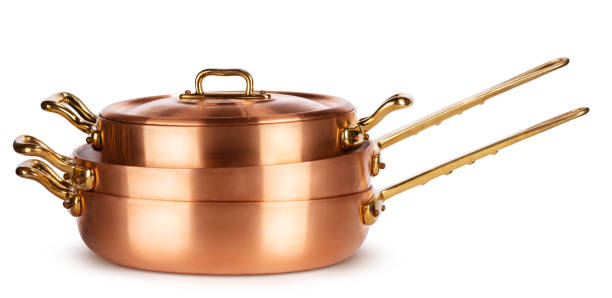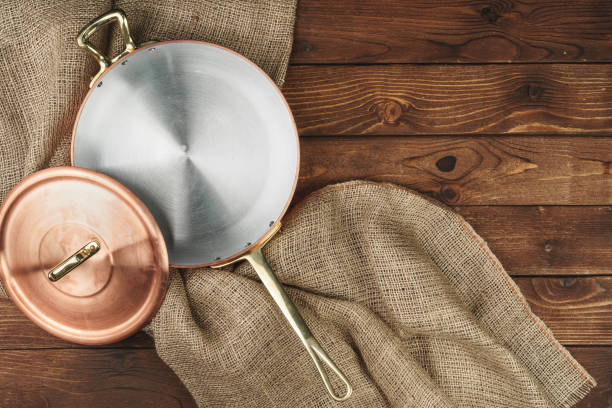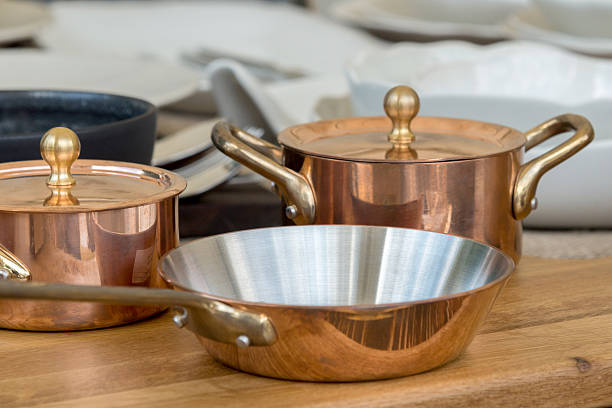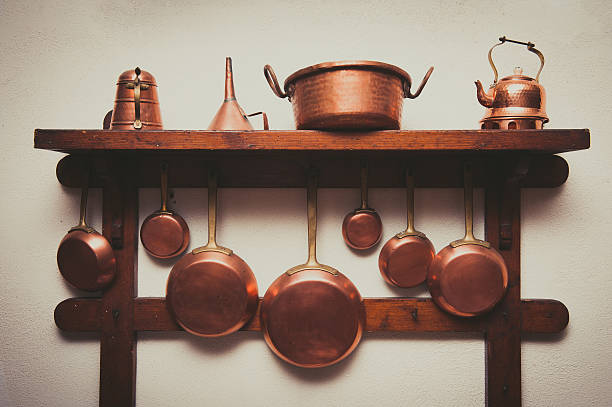In the mesmerizing world of culinary craftsmanship, where every sizzle and sear is a dance of flavors, the choice of cookware becomes a vital choreography. Picture this: the allure of copper pans, gleaming like molten sunsets in your kitchen.
Yet, amid the culinary ballet, a question tiptoes into the minds of aspiring chefs and seasoned cooks alike – do copper pans scratch easily?
As we embark on this culinary odyssey, we unravel the delicate choreography between the beauty of copper and the fear of unsightly marks, exploring the nuances of this kitchen tango where aesthetics and practicality intertwine.

Do Copper Pans Scratch Easily
Copper pans scratch easily because copper is a relatively soft metal compared to other cookware materials.
The surface of copper pans can be prone to scratches and abrasions when exposed to utensils or cleaning tools with harder materials.
Factors Influencing Scratch Vulnerability:
1. Material Composition
Copper pans are not made entirely of pure copper due to its soft nature. They are typically lined with materials like stainless steel or tin to enhance durability. However, the outer copper layer remains exposed, making it susceptible to scratches from abrasive utensils.
2. Utensil Selection
The choice of utensils plays a pivotal role in preserving the pristine surface of copper pans. Using metal utensils or scouring pads with abrasive surfaces increases the likelihood of scratches. Opting for softer utensils like wooden or silicone ones is advisable to mitigate this risk.
Caring for Your Copper Pans
1. Cleaning Techniques
Gentle cleaning practices are essential to prevent scratches. Avoid abrasive cleaners and harsh scrubbing, opting instead for mild detergents and soft sponges. Regular maintenance with non-abrasive methods helps preserve the pan’s appearance and functionality.
2. Storage Considerations
Proper storage is another key aspect of preventing scratches. Utilize pan protectors or stack pans with care to minimize contact between their surfaces. This simple precaution goes a long way in maintaining the pristine condition of your copper cookware.
Properties of Copper
Copper is a versatile metal renowned for its unique properties, which make it indispensable in various industries. Understanding these properties sheds light on its applications and significance in everyday life.
Softness and Malleability
Copper possesses remarkable softness and malleability, making it highly pliable and easy to work with. This inherent property allows for intricate shaping and forming without the risk of fracturing.
Copper wires, for instance, can be drawn into thin strands without breaking, enabling their use in electrical applications.
This softness stems from the arrangement of copper atoms in its crystalline structure, allowing for easy movement and deformation.
Such ductility is advantageous in manufacturing processes, facilitating the creation of intricate designs in jewelry, and ensuring the production of seamless pipes in plumbing applications.
Alloying with Other Metals
Copper exhibits the ability to form alloys by combining with other metals, enhancing its mechanical and chemical properties.
The most common alloy is brass, a mixture of copper and zinc, renowned for its corrosion resistance and distinctive gold-like appearance. Alloying expands the utility of copper, tailoring it to specific requirements in diverse industries.
Alloys provide a spectrum of desirable characteristics, such as increased strength, corrosion resistance, and improved hardness. This adaptability makes copper alloys valuable in applications ranging from electrical components to architectural accents, where durability and performance are paramount.
Impact on Scratch Resistance
Copper’s scratch resistance, or lack thereof, is a noteworthy aspect of its properties. While pure copper is relatively soft and susceptible to scratching, alloying it with other metals can enhance its resistance to abrasion.
For instance, bronze, a copper-tin alloy, is celebrated for its durability and resistance to scratches, making it a preferred material for sculptures and decorative items.
Understanding the impact of alloying on scratch resistance guides the selection of copper alloys based on the specific demands of the application. This versatility ensures that copper maintains its aesthetic appeal while meeting the functional requirements in various contexts.
Surface Coatings and Finishes
Surface coatings and finishes play a pivotal role in enhancing the functionality and aesthetics of various materials. Understanding different processes and their impacts provides valuable insights into the selection of coatings for specific applications.
Tinning and Lining Processes
Tinning and lining are surface coating processes that involve the application of thin layers of metal to the surface of a substrate, often to improve corrosion resistance or modify surface properties.
Tinning, for instance, commonly involves the application of a thin layer of tin to metals like steel or copper. This process forms a protective barrier, reducing the metal’s susceptibility to corrosion and enhancing its longevity.
In lining processes, materials like ceramics or polymers are applied as coatings to protect surfaces from chemical corrosion or to provide a non-reactive barrier. This is commonly seen in cookware, where a lining prevents the interaction between the food and the underlying metal, ensuring safety and extending the lifespan of the utensil.
Non-Stick Coatings
Non-stick coatings represent a significant advancement in surface technology, providing a slippery surface that resists adhesion of substances. Polytetrafluoroethylene (PTFE), commonly known as Teflon, is a well-known non-stick coating used in cookware.
This fluoropolymer coating offers exceptional non-stick properties, making it easier to cook with minimal oil and simplifying the cleaning process.
The application of non-stick coatings extends beyond cookware to industrial applications, such as molds in manufacturing. This reduces friction, prevents material buildup, and improves overall efficiency, emphasizing the versatility and practicality of non-stick surfaces in various fields.
Impact on Scratch Resistance
The impact of surface coatings on scratch resistance is a critical consideration in material selection for applications that require durability.
While some coatings, like hard anodizing on aluminum, significantly enhance scratch resistance, others, such as certain paints or decorative finishes, may be more susceptible to abrasion.
Understanding the correlation between coatings and scratch resistance guides decision-making in industries like automotive, where durability is paramount.
The application of scratch-resistant coatings not only preserves the aesthetics of surfaces but also ensures prolonged functionality, reducing maintenance costs and enhancing the overall user experience.

Factors Influencing Scratch Resistance
Scratch resistance is a crucial aspect in determining the durability and aesthetic longevity of various surfaces, particularly in everyday items like utensils.
Understanding the factors that influence scratch resistance helps in making informed decisions regarding material selection and maintenance practices.
Utensil Material and Design
The choice of material and design plays a pivotal role in the scratch resistance of utensils. Materials like stainless steel and certain alloys are renowned for their inherent durability and resistance to scratches.
The design of utensils, including the surface finish and protective coatings, can significantly impact their susceptibility to scratches.
For instance, utensils with smooth, polished surfaces or those coated with scratch-resistant materials exhibit enhanced resistance to abrasion.
The consideration of both material composition and design details guides consumers and manufacturers alike in selecting utensils that withstand the rigors of daily use, ensuring a longer lifespan and maintaining their visual appeal.
Cleaning Methods
The method employed for cleaning utensils is a key determinant of their scratch resistance. Abrasive cleaning tools or harsh chemicals can compromise the protective coatings or surface finishes, making utensils more susceptible to scratches over time.
Adopting gentle cleaning methods, such as using soft sponges or non-abrasive cleaners, helps preserve the integrity of the utensil’s surface.
Furthermore, understanding the compatibility of cleaning agents with specific materials is essential. For example, avoiding acidic cleaners on surfaces prone to corrosion ensures both cleanliness and scratch resistance.
Educating users on proper cleaning practices contributes to the overall maintenance of utensils and prevents unnecessary wear and tear.
Cooking Techniques
The manner in which utensils are used during cooking, including the choice of cooking utensils and the techniques employed, directly influences their scratch resistance.
Using appropriate utensils for specific cooking tasks reduces the likelihood of unintentional scratches. For example, using wooden or silicone utensils on non-stick cookware helps maintain the integrity of the coating.
Moreover, avoiding metal utensils on surfaces prone to scratches and adopting proper techniques, such as stirring and flipping with care, contributes to the overall preservation of scratch-resistant features.
This awareness of cooking techniques ensures that utensils remain functional and aesthetically pleasing throughout their lifespan.
Common Concerns Addressed
Addressing common concerns related to the use, cleaning, and storage of everyday items is essential for ensuring their longevity and optimal performance. Here, we delve into specific concerns associated with metal utensils, cleaning methods, and storage practices to provide insights for informed decision-making.
Impact of Metal Utensils
One prevalent concern is the potential impact of using metal utensils on various surfaces, particularly those with protective coatings or non-stick finishes.
Metal utensils, when used on such surfaces, can cause scratches, compromising the integrity of the coating and affecting the utensil’s performance over time.
To address this concern, it is advisable to opt for utensils specifically designed for use with non-stick cookware, such as those made from silicone or wood.
These materials provide effective alternatives, reducing the risk of scratches while maintaining the non-stick properties of the cookware. Being mindful of the utensils used during food preparation contributes to the overall longevity of kitchen tools.
Cleaning with Abrasive Materials
Concerns related to cleaning methods often revolve around the use of abrasive materials, which can contribute to surface wear and diminish the appearance of various items.
Cleaning with abrasive tools or harsh chemicals may erode protective coatings, leading to a decrease in scratch resistance.
To address this concern, adopting gentle cleaning practices using non-abrasive tools and mild cleaners is recommended. This preserves the integrity of surfaces, whether on cookware, appliances, or other household items.
Providing clear guidelines on suitable cleaning agents and methods for specific materials ensures users can maintain cleanliness without compromising the longevity of their possessions.
Storing and Stacking Practices
Concerns regarding the storage and stacking of items often arise due to the potential for scratches and damage during these processes. Improper stacking of utensils, dishes, or other items can result in surface abrasions or chipping, impacting both the appearance and functionality of the items.
To address this concern, adopting mindful storing and stacking practices is crucial. Using protective dividers, such as felt or silicone pads, between stacked items minimizes direct contact and reduces the risk of scratches.
Avoiding overcrowded storage spaces and opting for proper organization mitigates the chances of accidental damage, ensuring items remain in optimal condition.
 Comparisons with Other Cookware Materials
Comparisons with Other Cookware Materials
When it comes to selecting cookware, various materials offer distinct advantages and considerations. Comparing these materials provides valuable insights into their performance, durability, and suitability for different cooking styles.
Stainless Steel
Stainless steel cookware is celebrated for its durability and resistance to corrosion. It is a versatile and non-reactive material, making it suitable for a wide range of cooking applications.
The even heat distribution of stainless steel allows for precise cooking control. However, it may lack the non-stick properties found in other materials, requiring the use of oils or fats to prevent food sticking. Regular maintenance is crucial to prevent discoloration or stains.
In comparison to other materials, stainless steel stands out for its longevity, ease of cleaning, and compatibility with various cooking techniques. While it may not provide inherent non-stick features, its robustness and adaptability make it a preferred choice for professional and home kitchens alike.
Cast Iron
Cast iron cookware is renowned for its excellent heat retention and even heating properties. It is particularly favored for slow cooking and dishes that benefit from extended simmering.
While cast iron requires seasoning to maintain its non-stick surface, it can withstand high temperatures and is suitable for both stovetop and oven use. On the downside, it is heavier than some alternatives and requires careful maintenance to prevent rust.
In comparison to other materials, cast iron excels in heat retention and versatility. Its ability to develop a natural non-stick surface over time adds to its appeal. However, users need to consider its weight and invest time in proper seasoning and maintenance for optimal performance.
Non-stick Coatings
Non-stick coatings, such as those made with polytetrafluoroethylene (PTFE), offer unparalleled convenience in cooking and cleaning. They require minimal oil or fat, making them an excellent choice for low-fat cooking.
However, they may have a limited lifespan and can be prone to scratches. Overheating can also affect the integrity of the coating, requiring careful temperature management.
In comparison to other materials, non-stick coatings excel in convenience and reduced fat usage. Their ease of cleaning and quick-release properties make them ideal for certain cooking applications. However, users should be mindful of their limitations, such as the potential for scratches and the need for careful temperature control.
Maintenance and Care Tips
Ensuring the longevity and optimal performance of cookware involves proper maintenance and care. Here are essential tips for seasoning and re-tinning, selecting recommended cleaning tools, and adopting proper storage techniques.
Seasoning and Re-tinning
1. Seasoning
Regularly seasoning cast iron cookware is essential for maintaining its non-stick surface and preventing rust. To season, apply a thin layer of oil to the entire surface, then heat the cookware in the oven. Repeat this process to build a protective layer.
2. Re-tinning
For copper cookware, re-tinning the interior lining helps preserve its conductivity and prevent metal leaching. Seek professional re-tinning services or use a commercial re-tinning kit. Regularly inspect the lining for signs of wear and address promptly.
Proper seasoning and re-tinning not only enhance the performance of cookware but also contribute to its longevity. Regular upkeep ensures that these materials remain in top condition, ready for various culinary endeavors.
Recommended Cleaning Tools
1. Gentle Cleaning Tools
Opt for soft sponges, microfiber cloths, or non-abrasive brushes to clean cookware surfaces. Avoid abrasive tools that may scratch or damage protective coatings.
2. Mild Cleaning Agents
Use mild cleaners or natural solutions for cleaning. Harsh chemicals can erode protective layers and diminish scratch resistance. Baking soda, vinegar, or specialized mild cleaners are suitable alternatives.
Choosing the right cleaning tools and agents preserves the integrity of cookware surfaces, preventing unnecessary wear and ensuring their longevity. Educating users on suitable options promotes responsible maintenance practices.
Proper Storage Techniques
1. Protective Dividers
Place protective dividers, such as felt or silicone pads, between stacked items to prevent direct contact and minimize the risk of scratches or damage.
2. Avoid Overcrowding
Store cookware with adequate spacing to avoid overcrowding. Proper organization reduces the likelihood of accidental damage during storage.
Adopting proper storage techniques safeguards cookware from scratches and damage, ensuring that items remain in optimal condition between uses. Mindful organization contributes to the overall longevity and functionality of kitchen tools.

Real-world Experiences and Testimonials
Understanding how cookware performs in real-world scenarios is crucial for making informed decisions. Here are insights from user testimonials, expert opinions, and practical examples of long-term use, providing a comprehensive view of cookware durability.
User Testimonials on Scratch Resistance:
1. Non-Stick Cookware
Users frequently praise the scratch resistance of high-quality non-stick coatings. Testimonials often highlight the convenience of cooking with minimal oil and the easy cleanup process, emphasizing the longevity of the non-stick surface.
2. Stainless Steel Users
Stainless steel cookware users appreciate its robustness and scratch resistance. Many testimonials note the enduring shine and lack of visible scratches, even after prolonged use and exposure to various cooking utensils.
User testimonials shed light on the day-to-day experiences with cookware materials, offering insights into the practicality and durability of scratch-resistant features.
Expert Opinions and Reviews:
1. Cookware Experts
Experts often underscore the importance of proper care to maintain scratch resistance. They provide insights into selecting suitable materials for specific cooking styles and emphasize the impact of cleaning methods on the longevity of protective coatings.
2. Product Reviews
In-depth reviews by culinary experts often analyze scratch resistance based on rigorous testing. They evaluate cookware under various conditions, providing valuable information on the performance and durability of different materials.
Expert opinions and reviews contribute valuable insights into the technical aspects of scratch resistance, guiding consumers in making informed choices.
Practical Examples of Long-Term Use
1. Cast Iron Stories
Long-term users of cast iron cookware share stories of pans passed down through generations. These anecdotes often highlight the development of a seasoned, non-stick surface over time, showcasing the resilience and enduring quality of the material.
2. Copper Cookware Tales
Users of copper cookware discuss the patina that forms on the surface with extended use. These practical examples illustrate how the natural oxidation process contributes to both aesthetics and increased scratch resistance.
Practical examples of long-term use provide a glimpse into the lasting qualities of cookware materials, emphasizing their ability to withstand the test of time.
Debunking Myths
Cookware often carries misconceptions that can impact decisions and usage. Let’s dispel common myths, clarify the importance of proper maintenance, and highlight the versatility of copper pans.
Dispelling Common Misconceptions
1. Scratch Resistance Means Invincibility
Myth: Scratch-resistant cookware is thought to be indestructible. Reality: While it provides durability, it doesn’t guarantee invincibility. Proper care is crucial to prevent premature wear, and users should be mindful of the materials’ limitations.
2. All Non-Stick Coatings are Equal
Myth: All non-stick coatings are assumed to be the same. Reality: The quality varies, and the composition affects performance. Choosing reputable brands ensures better durability, and understanding the specifics of each coating type is vital.
Dispelling misconceptions about scratch resistance and non-stick coatings promotes a more realistic understanding of cookware attributes.
Clarifying the Role of Proper Maintenance
1. Non-Stick Cookware is Maintenance-Free
Myth: Non-stick cookware is believed to require no maintenance. Reality: Regular, gentle care is essential to preserve the non-stick surface. Abrasive tools and overheating can compromise the coating.
2. Seasoning is Solely for Cast Iron
Myth: Seasoning is considered exclusive to cast iron. Reality: Other materials, like carbon steel or certain stainless steels, benefit from seasoning to enhance non-stick properties and prevent corrosion.
Clarifying that all cookware demands maintenance helps users grasp the importance of proper care in ensuring longevity.
Highlighting the Versatility of Copper Pans
1. Copper Pans are High-Maintenance
Myth: Copper pans are often seen as high-maintenance. Reality: While occasional polishing may be required for appearance, the natural patina that forms enhances scratch resistance and adds aesthetic appeal.
2. Copper Pans are Only for Professionals
Myth: Copper pans are thought to be exclusive to professional chefs. Reality: Copper pans are versatile and suitable for home cooks. Their excellent heat conductivity allows for precise temperature control.
Emphasizing the versatility of copper pans challenges stereotypes and makes them more accessible for a broader audience.

FAQs
Do copper pans scratch easily?
Not at all! Copper pans are known for their exceptional durability and resistance to scratches. The smooth surface of these pans makes them less prone to scratches, ensuring a long-lasting and pristine appearance.
Can I use metal utensils with copper pans without worrying about scratches?
Absolutely! Copper pans are designed to withstand the use of metal utensils. Their robust construction minimizes the risk of scratches, giving you the freedom to cook with confidence and convenience.
Will frequent cleaning cause scratches on my copper pans?
No need to worry! Copper pans are easy to clean and maintain. Their resilient surface is less susceptible to scratches even with regular cleaning. So, feel free to keep your copper pans spotless without compromising their integrity.
Are copper pans scratch-resistant when used on different cooktops?
Yes, indeed! Whether you’re cooking on a gas stove, electric range, or induction cooktop, copper pans maintain their scratch-resistant quality. This versatility allows you to enjoy scratch-free cooking across various kitchen setups.
Can I stack copper pans without the fear of scratches?
Absolutely! The non-scratch nature of copper pans extends to stacking convenience. Their durable exteriors ensure that stacking pans for storage won’t result in unsightly scratches, preserving both the appearance and functionality of your cookware.
Do scratches affect the performance of copper pans over time?
Not at all! The exceptional conductivity of copper pans remains unaffected by minor scratches. These pans continue to deliver top-notch performance, making them a reliable choice for cooking enthusiasts who prioritize both durability and functionality.
How can I maintain the scratch-free appearance of my copper pans?
Maintaining the pristine look of your copper pans is a breeze! Simply follow the manufacturer’s care instructions, avoid using overly abrasive cleaners, and you’ll enjoy scratch-free cooking for years to come.
Will the color of my food change if copper pans get scratched?
No need to worry about any color changes in your food! Copper pans are designed to maintain their integrity even if they develop minor scratches. Your culinary creations will continue to look and taste delicious, unaffected by the cookware surface.
How do copper pans maintain their scratch resistance with regular use?
Copper pans have a natural protective layer that develops over time, contributing to their scratch resistance. Regular use and proper maintenance actually enhance their durability, ensuring that these pans remain a reliable and scratch-free kitchen companion.
Conclusion
In conclusion, the durability of copper pans largely depends on their construction and the presence of protective coatings. While pure copper pans are prone to scratching due to their soft nature, modern variations often come equipped with resilient coatings or incorporate durable materials in their design to mitigate this issue.
It is crucial for users to follow proper care and maintenance guidelines, avoiding the use of abrasive utensils and harsh cleaning methods to preserve the longevity of their copper cookware.
Ultimately, with mindful usage and appropriate care, copper pans can offer a balance of aesthetic appeal and functional performance in the kitchen without succumbing easily to scratches.